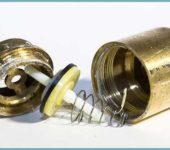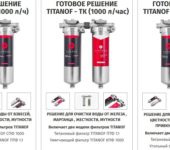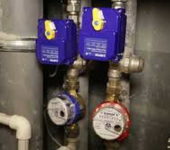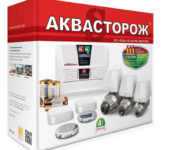How to choose a pumping station for home and summer cottages
Household pumping station - equipment for the automated supply of water to a private house. It can supply water from any source: a well, a well, a central water supply system or a river. The advantage of installing such a device is constant pressure in the water supply system, which allows you to connect any household appliances.
Pumping stations for water supply of a private house or summer cottage consists of:
- pump;
- hydroaccumulator;
- control and automation groups.
For its performance, a guaranteed power supply is required. The installation itself is autonomous and does not require any intervention: water is supplied with constant pressure - there is a difference, but it is small and not felt by equipment, and even more so by consumers.
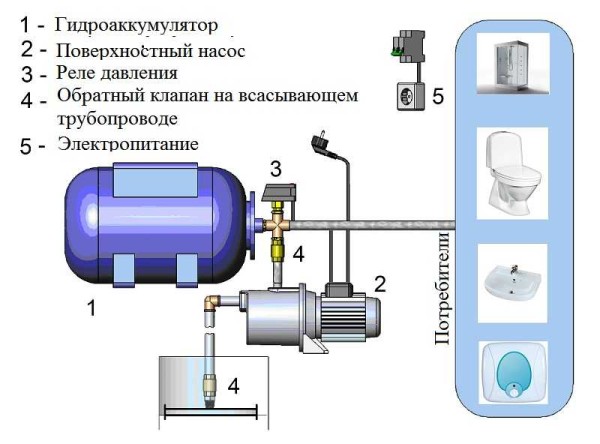
Mandatory components of pumping stations for water supply of a private house (suburban or within the city)
The content of the article
Pumping stations for water supply of a private house: principle of operation
In modern pumping stations for water supply, hydraulic accumulators are installed, which represent a cylindrical container, divided into two parts by an elastic membrane. One part of the tank is factory-filled with gas. A certain pressure is created in this chamber.
When the pump is turned on, water enters the second part of the accumulator. The container fills up gradually, the membrane expands, compressing the gas in the second part even more. In this way, pressure is created in the water supply system of a private house (dacha). Its value is controlled by sensors pressure switch... When the threshold value (about 2-4 atm) is reached, the sensors give a command to turn off the pump. Until the taps in the system are open, the pressure is stable, the pump no longer works.
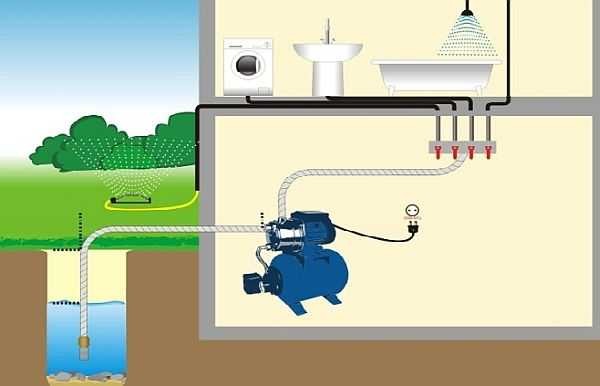
The principle of operation of pumping stations: pumping water as needed into a special reservoir - a hydraulic accumulator
A tap opens somewhere. Water enters it from a hydraulic accumulator, in which the pressure gradually decreases as the flow rate. When the lower threshold is reached, the second sensor is triggered, which gives a command to start the pump, water begins to flow again, equalizing the pressure. After the tap is closed, the pump works for some time, then it turns off.
Thus, a stable pressure is maintained in the system. This means that you can use any equipment in the house - both a washing machine, a dishwasher and water heater. If desired, you can organize automated watering of the site or lawn.
Types and types, connection features
The main working part of this equipment is a pump. It is its type that determines their main technical characteristics. The pumps will be discussed.
Surface and submersible
Most of the stations supplied from the factories assembled are equipped with surface pumps. They are installed on the same frame with a hydraulic accumulator and a control group. A pipeline is connected to the pump, which is lowered into the source - a well, a well, etc. This option is good because it can be used in narrow wells - the pipe diameter can be from 32 mm, which is normal even for the narrowest well. But such systems can raise water from a depth of about 7-10 meters.
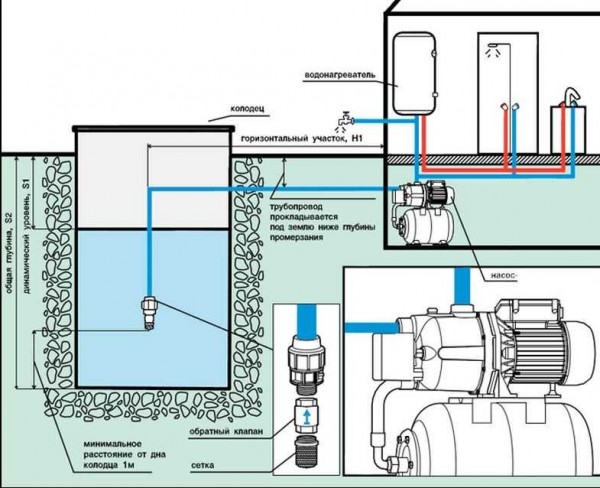
Water supply scheme of a private house with a pumping station with a surface pump
When installing such equipment, a filter and a check valve must be installed at the end of the supply pipeline submerged in water.A filter (mesh) is required, since the pumps are demanding on the quality of the water, and the check valve prevents water from draining while pumping is not in progress. Without these two parts, the system is ineffective.
If the well is deep, a submersible pump or installation with a remote ejector is required. In this case, the ejector is lowered into a well or a well, two hoses are connected to it. The rest of the equipment is on the surface. With such a system, water can rise from a depth of 40-45 meters.
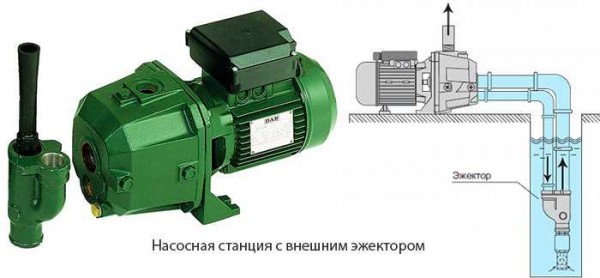
A pumping station with an external submersible ejector allows you to get water from deep wells or boreholes up to 40-45 m deep
The disadvantage of this system is that it does not like the presence of air in the pipes (hoses), which is why starting the system is a troublesome and responsible event.
Quiet and noisy
The internal design of the pumps is also different. The noise level during operation depends on their structure.
- Vortex. The suction force is generated by the blades inside the housing. These pumping stations for home water supply are silent or very quiet, but they can only raise water from a shallow depth. They can and should be installed in residential buildings: they really do not like temperature changes, and when they freeze they fail.
- Centrifugal pumps make a lot of noise during operation, but they pump water from decent depths and can operate at different temperatures, therefore they can be installed in specially equipped pits.
How to conduct water from a well or a well into a house, read here.
Pumping station installation rules
For the operation of the pumping station, it is necessary power supply. And this is one of the main criteria when choosing an installation site: you need to either install the station where there is power supply, or pull the line to where the station is. But there are a number of other factors to consider:
- The equipment should be installed taking into account the distance over which water can be supplied.
- If it is planned to use the system in winter, then the room in which the equipment is installed must be warm - the stations cannot tolerate frost. At the same time, there must be good ventilation in it so that condensation does not accumulate.
- If the pump makes a lot of noise, and it is more convenient to install it in or near the house, it must be enclosed in a soundproof box.
Sometimes the best way out is to build a caisson - a small room that is arranged at about a depth of 2.5 m. If the water intake comes from a well, then the casing is cut just above the bottom of the caisson. A pump is immersed in the well, which supplies water to the accumulator.
The equipment is installed below the freezing depth of the soil, which prevents it from freezing: a positive temperature is kept inside. It is convenient then to lay pipes below the freezing depth, and bring them out already under the house, in a warm non-freezing zone, and supply water to the comb.
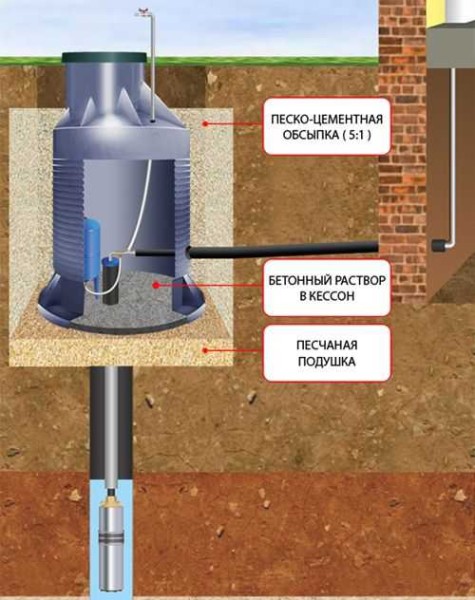
Installation diagram of a water supply station for a private house in a caisson
If for a house the installation of a caisson is a justified expense, then for a summer residence it is hardly. Then they make a simplified version - they build a small box or make a pit and put the equipment there for the spring-summer period, taking it to a heated room for the winter.
The water supply system in the country is described in the article "How to make a water supply in the country: choose pipes, scheme, method of installation"
How to choose a pumping station for your home
In addition to pump types, when choosing pumping stations for water supply of a private house, you need to pay attention to a number of parameters:
- Distance from the water intake point to the pump installation. Determines how close the equipment should be to the water source.
- Height of water rise - how far relative to the place of water intake it can be supplied. Note that extended horizontal sections must also be considered.
- Productivity is the amount of water that can be supplied per unit of time. To calculate this parameter, you can use the average consumption rates depending on the type of consumer (see table).
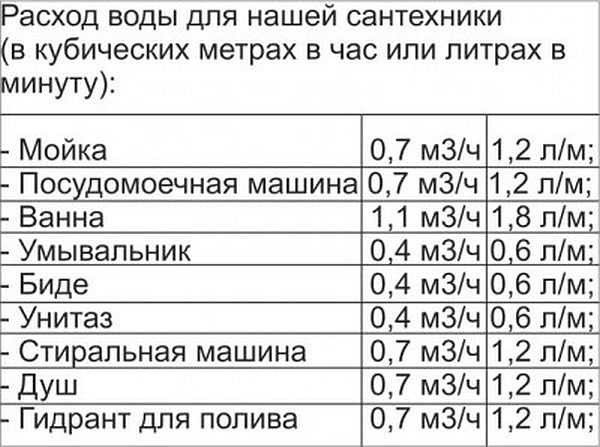
Having calculated the average flow rate, you can choose the capacity of the pumping station
- Accumulator volume. The larger it is, the more water you will have in reserve in case of a power outage. But this is far from the most important point. It is much more important that at large volumes the pump turns on less often, which means a longer service life. But hydroaccumulator - an expensive piece and the larger it is, the more expensive it is. Please note: expansion tanks similar in structure, although they are cheaper, cannot be bought. They are not suitable for water (they are used to stabilize the pressure in gas pipelines) and quickly break down, moreover, the water becomes unfit for drinking (an unpleasant smell and taste appears).
When choosing a model, it is worth paying attention to additional functions. A useful option is protection against overheating and against idling (when there is no water). They extend the life of the equipment.
You can also choose a pump housing. It is made of steel, stainless steel, cast iron, high density polypropylene. Polypropylene is the most inexpensive. It does not rust, does not transmit noise during operation. But although it is of high density, it is plastic, and if handled carelessly (during transportation, for example) it can be damaged. The second in cost is steel, but when using a centrifugal pump, the housing transmits noise, and sometimes also resonates. So these pumps run loud. A similar one installed in cast iron is quieter. But with acidic water, cast iron quickly rusts, which is not encouraging: there is usually an excess of iron in the water. The most optimal in terms of durability is a stainless steel case, but they are the most expensive.
Read about water purification from a well or well here.
What if there is no station with the required characteristics? Assemble yourself. All the required spare parts are commercially available, everything is connected using conventional fittings. How - see the video below. By the way, a self-assembled pumping station costs less than a purchased one, and it will be easier for you to repair it: you connected everything yourself.
Popular brands
The most popular water supply pumping stations for a private house are Jileks Jumbo today. They have low prices, the quality is not bad. They are produced with pumps made of cast iron (letter "CH" in the marking), polypropylene (stands for "P"), and stainless steel ("N"). There are also numbers in the marking: “Jumbo 70- / 50 P - 24. It stands for this: 70/50 - maximum water flow 70 liters per minute (productivity), head - 50 meters, P - polypropylene body, and number 24 - the volume of the accumulator.
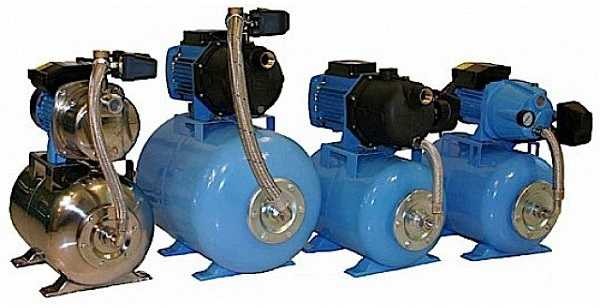
Water supply pumping stations for a private house Dzhileks are externally similar to units from other manufacturers
The price of a pumping station for the water supply of the Jileks house starts at $ 100 (mini options with low power and for a low flow rate in a polypropylene case). The most expensive unit with a stainless steel body costs about $ 350. There are also options with a submersible pump. They can lift water from a depth of up to 30 meters, flow rates up to 1100 liters per hour. Such installations cost from $ 450-500.
Dzhileks pumping stations have installation requirements: the diameter of the suction pipeline must not be less than the diameter of the inlet. If the water rises from a depth of more than 4 meters and, at the same time, the distance from the water source to the house is more than 20 meters, the diameter of the pipe lowered from the well or well must be greater than the diameter of the inlet. This must be taken into account when installing the system and piping the pumping station.
You can see the reviews about JILEX JUMBO 60 / 35P-24 (in a plastic case, cost 130 $) in the photo below. This is part of the impressions left by the owners on the trading site.

Reviews of the pumping station for water JILEX JUMBO 60 / 35P-24 (to enlarge the picture, right-click on it)
Pumping stations Grundfos (Grundfos) work well for water supply at home. Their body is made of chrome-plated steel, accumulators for 24 and 50 liters.They work quietly and reliably, provide stable pressure in the system. The only drawback: spare parts are not supplied to the Russian market. If, suddenly, something is broken, you will not find "native" elements. But it must be said that the units break down infrequently.
Prices for pumping stations with surface pumps start at $ 250 (power 0.85 kW, suction depth up to 8 m, capacity up to 3600 liters / hour, height 47 m). A more efficient unit (4500 liters / hour with a higher power of 1.5 kW) of the same class costs twice as much - about $ 500. Reviews of the work are presented in the format of a photo taken on the website of one of the stores.

Reviews of Grundfos pumping stations for water supply at home or summer cottage (to enlarge the picture, right-click on it)
A series of Grundfos pumping stations with stainless steel pump bodies is very expensive, but they also have protection against idling, overheating, and water cooling. Prices for these installations are from $ 450. Modifications with borehole pumps are even more expensive - from $ 1200.
Water supply pumping stations for the Wilo house (Vilo) have proven themselves quite well. This is a more serious technique to ensure high flow rates: each station can have up to four normally suction pumps. The body is made of galvanized steel, the connecting pipes are made of stainless steel. Management - programmable processor, touch control panel. The performance of the pumps is infinitely adjustable to ensure a stable pressure in the system. The equipment is solid, but the prices are also about $ 1000-1300.

Wilo pumping stations are suitable for the water supply of a large house with a significant consumption. This equipment belongs to the class of professional
How to make an autonomous water supply in a house connected to a centralized water supply system with poor pressure or provide yourself on an ongoing basis with an hourly water supply, see the following video. And all this with the help of a pumping station and a water storage tank.

